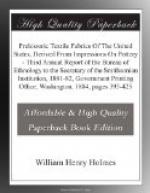Two series of threads are interwoven at right angles, the warp series being arranged in pairs and the woof singly. At each intersection the pairs of warp threads are twisted half around upon themselves, inclosing the woof threads and holding them quite firmly, so that the open mesh is well preserved even when much strained. Fabrics of this character have been employed by the ancient potters of a very extended region, including nearly all the Atlantic States. There are also many varieties of this form, of fabric resulting from differences in the size and spacing of the threads. These differences are well brought out in the series of illustrations that follow.
In regard to the manufacture of this particular fabric, I am unable to arrive at any very definite conclusion. As demonstrated by Miss Osgood, it may be knitted by hand, the threads of the warp being fixed at one end and the woof at both by wrapping about pegs set in a drawing board or frame, as shown in the diagram, Fig. 74.
[Illustration: Fig. 74.—Diagram
showing the method of weaving
Form 2.]
The combination is extremely difficult to produce by mechanical means, and must have been beyond the reach of any primitive loom. I have prepared a diagram, Fig. 75, which, shows very clearly the arrangement of threads, and illustrates a possible method of supporting the warp while the woof is carried across. As each thread of the woof is laid in place, the threads of the warp can be thrown to the opposite support, a turn or half twist being made at each exchange. The work could be done equally well by beginning at the top and working downward. For the sake of clearness I have drawn but one pair of the warp threads.
[Illustration: Fig. 75.—Theoretic device for working the twist.]
Fig. 76 illustrates a characteristic example of this class obtained from a fragment of pottery from the great mound at Sevierville, Tenn.
[Illustration: Fig. 76.—From fragment of mound pottery, Tennessee.]
The impression is quite perfect. The cords are somewhat uneven, and seem to have been only moderately well twisted. They were probably made of some vegetable fiber. It will be observed that the threads of the woof are placed at regular intervals, while those of the web are irregularly placed. It is interesting to notice that in one case the warp has not been doubled, the single thread having, as a consequence, exactly the same relation to the opposing series as corresponding threads in the first form of fabric presented. The impression, of which this is only a part, indicates that the cloth was considerably distorted when applied to the soft clay. The slipping of one of the woof threads is well shown in the upper part of the figure.
The fabric shown in Fig. 77 has been impressed upon an earthen vessel from Macon, Ga. It has been very well and neatly formed, and all the details of fiber, twist, and combination can be made out.




